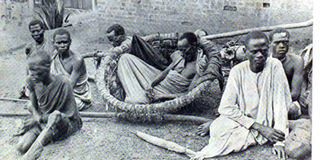When influenza pandemic claimed 25,000 lives in Uganda

A patient arrives at Mengo Hospital in the early 1900s. The founder, Dr Albert Cook, had influence on the decisions taken to fight the influenza outbreak. FILE PHOTO
As Uganda recovered from the ravages of the 1900 to 1910 sleeping sickness pandemic, the country underwent another wave of the influenza pandemic.
It was brought to the country by travellers coming from the eastern coast of Kenya. This was the first negative import of the Uganda Railway.
The first reports of the illness came on September 23, 1918, when Indian conscripts from Bombay arrived in the port of Mombasa sick with influenza.
These infected soldiers then travelled along the Uganda Railway, mobilising for war, and spreading the disease along this route.
“At the same time, migrant labourers and people traveling to find food during the famine exacerbated the spread of the epidemic. Within nine weeks of its introduction, influenza struck every district in Kenya, reaching even sparsely populated, outlying regions,” according to the Uganda Protectorate Annual Medical and Sanitary Report of 1919.
The influenza spread rapidly along the Uganda Railway, throughout the Uganda Protectorate from late October to December 1918.
The colonial authorities struggled to contain the pandemic with no success. It suddenly ended as it had started. Most of the victims were Africans staying in urban centres.
The 1919 medical report describes the pandemic as a “true influenza.” According to the report, the victims had a few days to fight the dieses once they acquired it.
“It had a short course of about three to four days and it was frequently fatal. Those infected experienced a rapid onset of symptoms, including sore throat, cough, chills, intense body ache and feelings of tightness in the chest,” the report says.
Unlike Covid-19 that is wreaking havoc, especially among the older people, majority of victims of the 1918 influenza pandemic were the young and middle-aged.
This was a huge setback on the economic policies of the day as the victims constituted the backbone of the colonial administration’s labour force.
The 1919 medical report says the influenza in just a few months between October 1918 and June 1919 claimed more than 25,000 people.
“Judging from reports, it appears that the Uganda Protectorate suffered as much as any other part of Africa,” the report says.
Administrative response
Despite its high mortality rate, the influenza did not take centre stage in the government’s plans. A less deadly venereal disease outbreak was given more attention and combating it shaped public health policies of the time.
The response to the outbreak was determined by its impact on the political and economic context, not its mortality rates.
Prior to the outbreak, both the colonial and local administrations were concerned more about the health, depopulation and reproduction of the Ugandans.
During the colonial times, Uganda was a protectorate, unlike most African countries. As a result, the colonial rulers did not rely entirely on foreign manpower for administrative work.
The British turned to Buganda Kingdom chiefs and elite to run the local affairs on their behalf through the indirect rule system.
Some members of the Church Missionary Society, and medical missionaries such as Dr Albert Cook, had influence on the decisions taken to fight the influenza outbreak.
“These groups entangled, but by no means had identical political interests, largely determined what disease issues received priority,” the 1920 Medical and Sanitation Report says.
The little attention paid to the influenza pandemic was mainly because of the political interests. Colonial authorities by 1918 were still coming to terms with the aftermath of the sleeping sickness pandemic.
Sleeping sickness had a toll on both the population and economy. By the time it broke out, the colonial and local authorities were struggling with the syphilis outbreak.
Despite the high influenza mortality rate, the Medical and Sanitation Department (now Ministry of Health) in its report of 1920 noted that, “Even though medical authorities and administrators noted influenza was unusually devastating, they responded to this mass mortality with calls for venereal disease control.”
Although various epidemics presented problems in the post-World War I period, few influenced the course of public health in Uganda than venereal diseases.
“The influenza epidemic of 1918 to 1919 certainly seemed to have little, if any, impact,” The report stated.
Writing in the 58th issue of the Geographical Journal in 1921, under the title ‘The Lango District’ JH Driberg said, “the Lango District Commissioner also noted that the influenza mortality in 1918 far surpassed mortality from established epidemics in the 1910s plague like smallpox, and cerebrospinal meningitis.”
“Lango had to be safeguarded from contamination by their less happy neighbours,” he wrote.
Although the colonialists were preoccupied with African depopulation and reproduction in the first decades of their rule, the high influenza mortality rates did not seem to bother them much.




